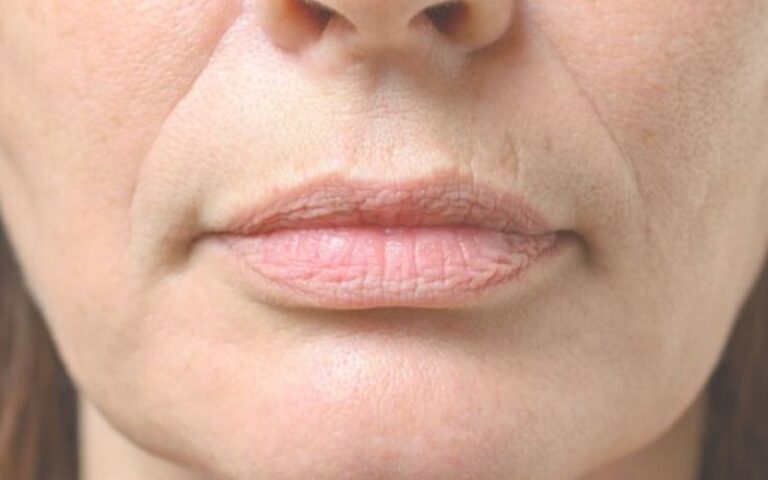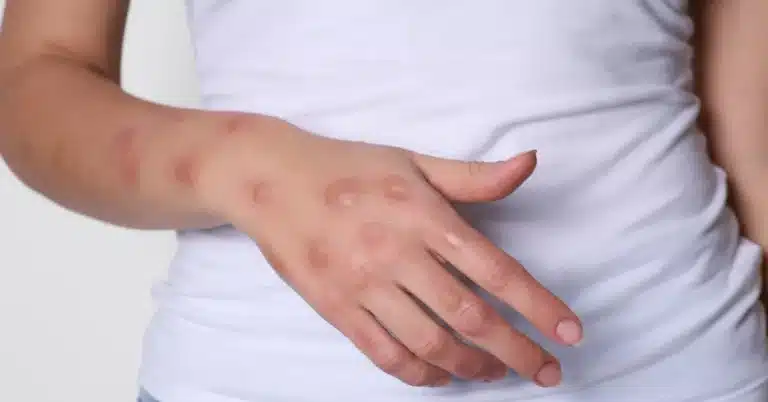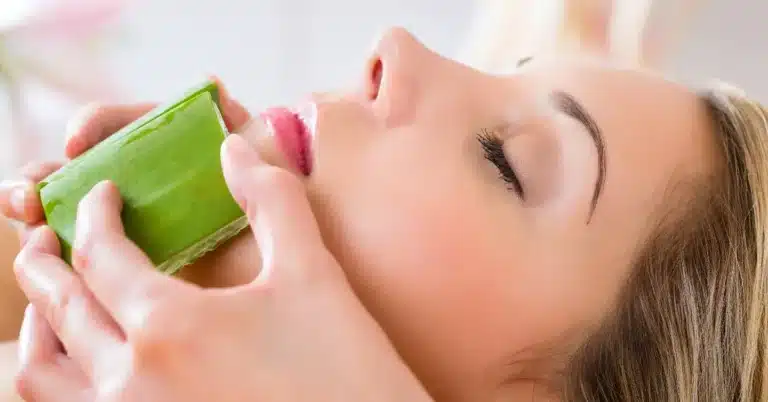Overcoming Folliculitis After Waxing: Effective Tips And Solutions
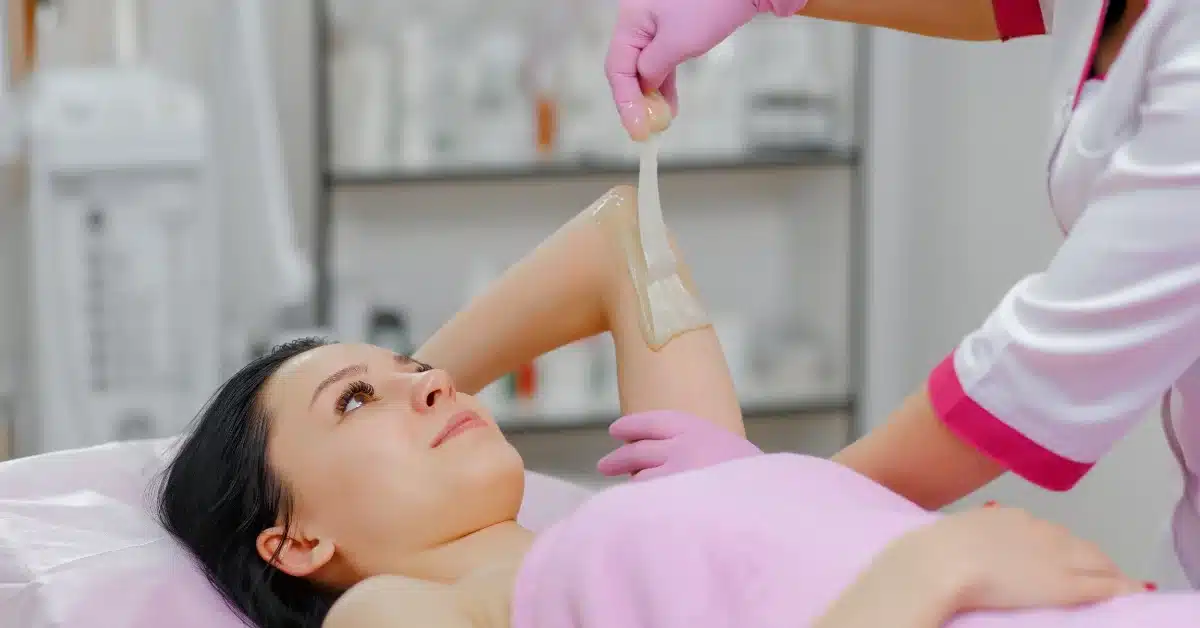
Folliculitis after waxing is a common concern for many individuals seeking smooth, hair-free skin. The condition occurs when hair follicles become inflamed or infected, resulting in red bumps, itching, and discomfort.
Whether you’re a seasoned waxing pro or a newbie to the hair removal game, this guide will equip you with the knowledge and solutions to say goodbye to those bumps once and for all. Get ready to enjoy silky smooth skin without the hassle of folliculitis!
Table Of Contents
- Causes of Folliculitis After Waxing
- Prevention Tips to Avoid Folliculitis After Waxing
- Post-Waxing Skincare Routine to Prevent Folliculitis
- Natural Remedies for Treating Folliculitis After Waxing
- Over-The-Counter Products for Treating Folliculitis After Waxing
- Home Care Tips for Managing Folliculitis After Waxing
- When to Seek Professional Help for Folliculitis After Waxing
- Minimizing the Risk of Folliculitis After Waxing
- Treating Ingrown Hairs and Folliculitis After Waxing
- Long-Term Solutions for Preventing Folliculitis After Waxing
- In A Nutshell
Causes Of Folliculitis After Waxing
Folliculitis after waxing can be attributed to various factors. Understanding these causes is crucial for devising effective prevention and treatment strategies:
Waxing-Related Folliculitis
Waxing involves removing hair from the root, which can cause irritation and inflammation of the hair follicles. Improper waxing techniques, such as using dull or dirty waxing tools, can also increase the risk of folliculitis.
Folliculitis after waxing can be caused by various factors, including:
- Bacterial Infection: Bacteria can enter the hair follicles during the waxing process, leading to infection and inflammation.
- Ingrown Hairs: When hair follicles become blocked, hair can grow sideways or curl back into the skin, causing inflammation and folliculitis.
- Skin Sensitivity: Some individuals have naturally sensitive skin, making them more prone to developing folliculitis after waxing.
- Poor Hygiene Practices: Insufficient cleansing before or after waxing can contribute to bacterial growth and folliculitis.
Post-Waxing Folliculitis
Post-waxing folliculitis occurs within a few days after waxing. This is because the skin is more vulnerable to bacteria and other microorganisms, which can lead to folliculitis. Poor hygiene practices, excessive sweating, and friction from tight clothing can exacerbate the condition.
It is crucial to differentiate this condition from the normal redness and mild irritation that can occur immediately after waxing. If you notice pus-filled bumps, severe redness, or persistent discomfort, it’s likely post-waxing folliculitis.
Prevention Tips To Avoid Folliculitis After Waxing
Preventing folliculitis after waxing involves proactive measures to maintain optimal skin health before, during, and after the waxing session. Here are some essential prevention tips:
Pre-Waxing Skin Preparation
Proper skin preparation is vital in preventing folliculitis after waxing. Follow these tips before your next waxing session:
- Cleanse Thoroughly: Wash the area to be waxed with a gentle cleanser to get rid of dirt, oils, and bacteria.
- Exfoliate: Gently exfoliate the skin a day or two before waxing to remove dead skin cells and reduce the risk of ingrown hairs.
- Avoid Sun Exposure: Shield your skin from the sun for at least 24 hours before waxing, as sunburned or tanned skin is more susceptible to irritation and folliculitis.
Choosing the Right Waxing Products
Using the appropriate waxing products can significantly reduce the chances of developing folliculitis. Consider the following:
- High-Quality Wax: Opt for professional-grade waxes specifically designed for sensitive areas, such as the bikini line or face.
- Hypoallergenic Wax: If you have sensitive skin, choose hypoallergenic wax that minimizes the risk of irritation.
- Clean and Sterile Tools: Ensure that the salon or aesthetician uses clean and sterilized waxing tools to prevent bacterial contamination.
Proper Waxing Technique for Folliculitis Prevention
The technique used during waxing can influence the occurrence of folliculitis. Here’s what you need to keep in mind:
- Experienced Esthetician: Choose an experienced esthetician who understands proper waxing techniques and maintains hygiene standards.
- Avoid Double Dipping: Double-dipping the wax applicator can introduce bacteria into the wax and subsequently to your skin. Ensure single-use applicators are used.
- Gentle Pulling: The aesthetician should pull the wax strip in the direction opposite to hair growth with a swift and gentle motion to minimize trauma to the hair follicles.
Post-Waxing Skincare Routine To Prevent Folliculitis
A consistent post-waxing skincare routine plays a vital role in preventing folliculitis and promoting skin healing. Incorporate the following steps into your routine:
1. Avoid touching the area
After waxing, restrain from touching the freshly waxed area as much as possible. Touching the area with dirty hands can introduce bacteria and increase the risk of folliculitis.
2. Gentle cleansing after waxing
After waxing, your skin needs gentle care and cleansing to prevent further irritation and infection. Use a mild cleanser. Cleanse the waxed area with a mild, pH-balanced cleanser to remove any wax residue, bacteria, or oils.
Avoid harsh scrubbing. Pat your skin dry instead of rubbing, and avoid using harsh scrubs or loofahs, as they can further irritate the skin.
3. Moisturizing to soothe the skin
Proper moisturization is essential for preventing dryness and soothing the skin after waxing. Apply a gentle, non-comedogenic moisturizer to the waxed area. Look for natural ingredients like chamomile or aloe vera for their soothing properties.
Steer clear of heavy creams or lotions that can clog the hair follicles, potentially leading to folliculitis.
4. Avoiding tight clothing and friction
Wearing tight clothing or subjecting freshly waxed skin to friction can exacerbate folliculitis. Wear loose clothing made of breathable fabrics to allow your skin to breathe and minimize friction.
5. Avoid hot baths or showers
Sweat can irritate freshly waxed skin and increase the risk of folliculitis. Avoid physical activities that cause excessive sweating, such as intense workouts, for at least 24-48 hours after waxing.
6. Avoid excessive sweating
Sweat can irritate freshly waxed skin and increase the risk of folliculitis. Avoid physical activities that cause excessive sweating, such as intense workouts, for at least 24-48 hours after waxing.
Natural Remedies For Treating Folliculitis After Waxing
If you’re seeking natural remedies to alleviate folliculitis after waxing, here are some effective options:
1. Tea Tree Oil for Post-Waxing Folliculitis
Tea tree oil possesses natural antibacterial and anti-inflammatory properties, making it an effective remedy for post-waxing folliculitis. Here’s how to use it:
- Mix a few drops of tea tree oil with a carrier oil, such as coconut or jojoba oil.
- Dab the diluted tea tree oil onto the affected area using a cotton ball or swab.
- Leave it on for 15 minutes, then rinse with water.
2. Aloe Vera for Soothing Waxing-Related Inflammation
Aloe vera has soothing and anti-inflammatory properties that can provide relief from waxing-related inflammation and redness. Try the following:
- Extract the gel from an aloe vera leaf or use store-bought aloe vera gel without added chemicals.
- Apply liberally and gently massage the gel onto the affected area.
- Leave it on until fully absorbed, and reapply as needed for soothing relief.
3. Chamomile Compresses for Folliculitis Relief
Chamomile is known for its calming and anti-inflammatory effects. Using chamomile compresses can help alleviate folliculitis symptoms. Here’s how:
- Brew a strong chamomile tea by steeping chamomile flowers in hot water for 10 minutes.
- Allow the tea to cool down to a comfortable temperature.
- Soak a clean cloth or cotton pads in the tea and gently apply it to the affected area for 10-15 minutes.
- Repeat this process several times a day to soothe the skin and reduce inflammation.
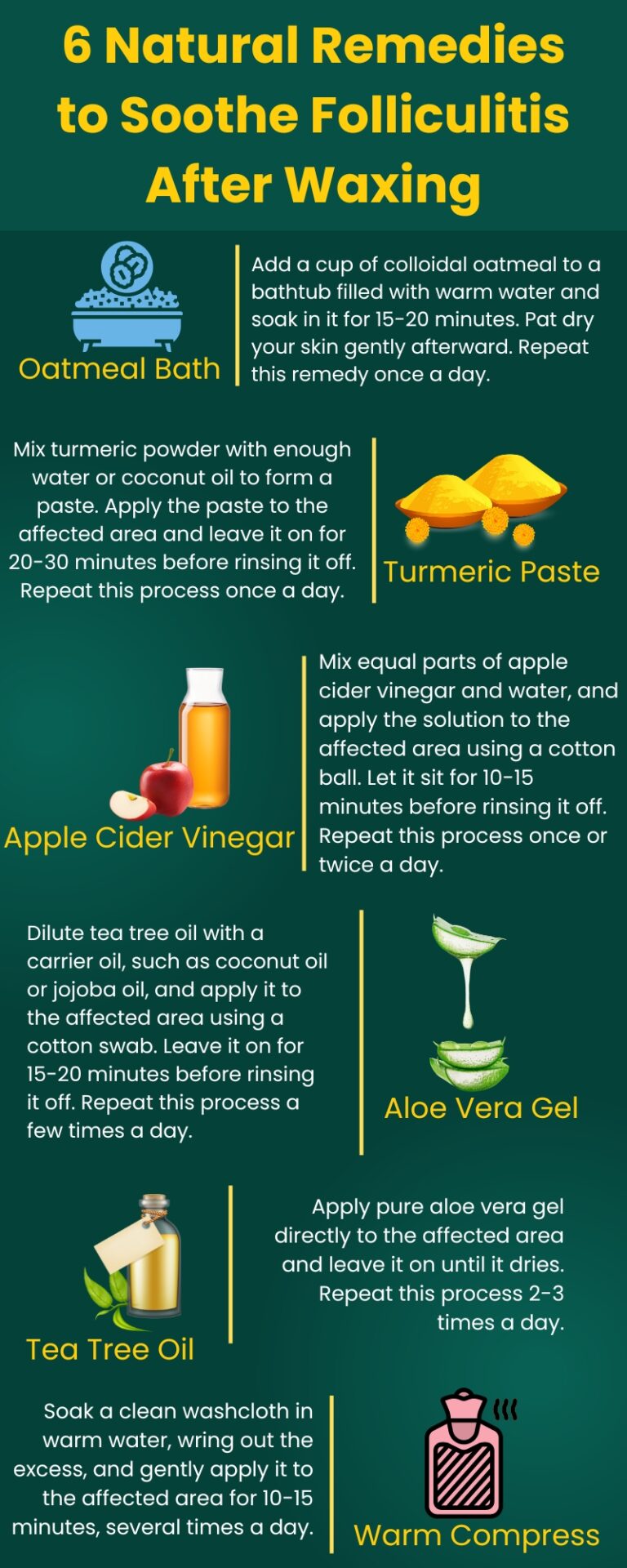
4. Apple Cider Vinegar for Balancing pH and Reducing Bacterial Growth
Apple cider vinegar has antimicrobial properties and helps balance the skin’s pH level, creating an unfavorable environment for bacteria to thrive. Use it in the following way:
- Dilute apple cider vinegar with water in a 1:1 ratio.
- Dip a cotton ball or pad into the mixture and apply it to the affected area.
- Leave it on for a few minutes, then rinse with water.
- Repeat this process once or twice a day to help alleviate folliculitis symptoms.
5. Coconut Oil for Moisturizing and Nourishing the Skin
Coconut oil is a natural moisturizer that can help soothe and nourish the skin, reducing redness and irritation. Here’s how to use it:
- Warm a small amount of coconut oil between your palms until it melts.
- Gently massage the oil onto the affected area.
- Leave it on overnight or for a few hours, then rinse with lukewarm water.
- Repeat this process daily to keep the skin moisturized and aid in healing.
6. Witch Hazel for Its Astringent and Anti-inflammatory Properties
Witch hazel is a natural astringent that can help reduce inflammation and soothe irritated skin. It also has antimicrobial properties. Follow these steps:
- Soak a cotton pad or ball in witch hazel extract.
- Apply it to the affected area, gently pressing it against the skin.
- Leave it on for a few minutes, then rinse with water.
- Repeat this process several times a day to alleviate symptoms and promote healing.
Note: Before using any natural remedy, you must do a patch test on a small area of your skin to check for any adverse reactions. If you experience any discomfort or allergic reactions, discontinue use immediately.
Incorporate these remedies into your skincare routine to soothe your skin and restore health. Always choose high-quality natural ingredients and listen to your skin’s needs.
Over-The-Counter Products For Treating Folliculitis After Waxing
If natural remedies aren’t providing sufficient relief, over-the-counter products can help manage folliculitis after waxing.
Antibacterial Creams
Look for topical creams or ointments containing antibacterial ingredients such as benzoyl peroxide or neomycin. These products can help reduce bacterial growth and inflammation associated with folliculitis.
Bacitracin and Neosporin are effective over-the-counter options for treating post-waxing folliculitis. Apply as directed on the packaging.
Hydrocortisone Ointments
Hydrocortisone ointments or creams can provide relief from itching, redness, and inflammation caused by folliculitis.
Choose a low-strength (0.5% to 1%) hydrocortisone ointment or cream. Use a thin layer of the ointment on the affected area once or twice a day for a limited duration (as directed by the package or healthcare professional).
Salicylic Acid-Based Products
Products containing salicylic acids, such as gels or lotions, can help exfoliate the skin, unclog hair follicles, and minimize the risk of ingrown hairs and folliculitis. Follow the instructions rendered on the product for safe and effective use.
Try these options:
- Salicylic Acid Lotion: Apply a salicylic acid lotion to the affected area after waxing to keep the pores clear and prevent folliculitis.
- Exfoliating Pads: Use pre-soaked salicylic acid exfoliating pads to gently swipe over the waxed area to prevent ingrown hairs and reduce inflammation.
Home Care Tips For Managing Folliculitis After Waxing
In addition to remedies and over-the-counter products, certain home care practices can aid in managing folliculitis after waxing.
- Applying warm compresses to the affected area can help decrease inflammation, soothe the skin, and promote healing. Soak a clean cloth in warm water, wring out the excess, and gently press it against the folliculitis-affected skin for 10-15 minutes.
- Give your skin time to heal by avoiding any further hair removal in the affected area until the folliculitis has cleared up. This will help prevent additional irritation and potential infection.
- Maintain good hygiene by regularly cleansing the affected area with a mild, antibacterial cleanser.
- Avoid picking or scratching the bumps, as this can worsen the condition and increase the risk of infection.
When To Seek Professional Help For Folliculitis After Waxing
While most cases of folliculitis after waxing can be managed at home, there are instances when seeking professional help is necessary. Consider the following situations:
Severe or Persistent Folliculitis After Waxing
If your folliculitis symptoms worsen or persist despite home care measures, it’s crucial to seek professional help. Reach out to a dermatologist if:
- The condition does not improve after a week of home care.
- The bumps become larger, more painful, or start to ooze pus.
- You experience signs of infection, such as fever, increased redness, or spreading warmth.
Signs of Infection or Worsening Symptoms
Certain signs may indicate an infection or worsening of folliculitis. If you notice any of the following, consult a healthcare professional:
- If the pain becomes severe or unbearable, it may indicate a more serious infection.
- If the redness spreads beyond the waxed area or worsens, it could be a sign of an infection.
- The presence of pus or fluid draining from the bumps suggests an infection and requires medical attention.
If you have a history of recurring folliculitis or are unsure about the best course of action for your situation, consult a dermatologist. They can provide expert guidance, tailor treatments to your needs, and offer valuable advice on preventing future episodes.
Minimizing The Risk Of Folliculitis After Waxing
To minimize the risk of folliculitis after waxing, following proper aftercare instructions and taking preventative measures is important.
Proper Aftercare Instructions from Professionals
Following the aftercare instructions provided by your esthetician or waxing professional is crucial for minimizing the risk of folliculitis. Pay attention to their advice regarding cleansing, moisturizing, and avoiding certain activities post-waxing.
Choosing Experienced and Hygienic Waxing Salons
Choose a reputable and hygienic waxing salon to reduce the risk of folliculitis. Consider the following factors:
- Esthetician’s Experience: Opt for salons with experienced estheticians who are knowledgeable about proper waxing techniques.
- Cleanliness Standards: Ensure that the salon follows strict hygiene practices, including the use of clean and sterilized tools and single-use applicators.
Avoiding Waxing on Sensitive or Irritated Skin
Waxing on already sensitive or irritated skin increases the likelihood of developing folliculitis. Take the following precautions:
- Wait for Skin Recovery: If your skin is sunburned, irritated, or has open wounds, wait until it has fully healed before scheduling a waxing session.
- Communicate with an Esthetician: Inform your esthetician about any skin conditions or sensitivities you may have to ensure they can adapt the treatment accordingly.
Treating Ingrown Hairs And Folliculitis After Waxing
Ingrown hairs often accompany folliculitis after waxing. Here are some tips for identifying, managing, and preventing ingrown hairs:
Identifying and Managing Ingrown Hairs
Ingrown hairs occur when hair curls back or grows sideways into the skin, causing inflammation and red bumps.
Look for small, red bumps resembling pimples that often have hair trapped beneath the skin’s surface. Use sterile tweezers to lift the ingrown hair gently. Avoid aggressive plucking, as it can cause further inflammation.
Exfoliation Techniques for Preventing Ingrown Hairs
Regular exfoliation helps prevent the buildup of dead skin cells and minimizes the risk of ingrown hairs.
- Physical Exfoliation: Use a gentle scrub or exfoliating mitt to slough off dead skin cells in the waxed area, promoting proper hair growth.
- Chemical Exfoliation: Incorporate products containing gentle exfoliating acids, such as glycolic or lactic acid, into your skincare routine to keep the skin clear.
However, be mindful not to over-exfoliate, as it can irritate the skin.
Specific Treatments for Ingrown Hair-related Folliculitis
For stubborn ingrown hairs or persistent folliculitis caused by them, consider using products containing glycolic acid or retinoids. These can help to exfoliate the skin, unclog hair follicles, and reduce inflammation.
Long-Term Solutions For Preventing Folliculitis After Waxing
Preventing folliculitis after waxing is an ongoing process. By incorporating these long-term prevention strategies into your routine, you can maintain smooth, irritation-free skin:
Considering Alternative Hair Removal Methods
If folliculitis continues to be a recurring issue, consider exploring alternative hair removal methods that are better suited to your skin.
- Laser treatment can provide a long-term reduction in hair growth and minimize the risk of folliculitis.
- Depilatory creams dissolve the hair, eliminating the need for waxing and reducing the likelihood of folliculitis.
Hair Growth Inhibiting Products for Prolonged Results
Using hair growth-inhibiting products can help slow down hair regrowth and minimize the frequency of hair removal sessions. Look for products containing ingredients like soy extract, which can inhibit hair growth and reduce hair density. The other one is Saw palmetto extract, which has anti-androgenic properties and can help reduce hair growth.
Gradual Hair Removal Techniques to Reduce Irritation
If you prefer to stick with waxing, adopting gradual hair removal techniques can help minimize skin irritation and folliculitis risk:
- Longer Intervals Between Sessions: Increase the time between waxing sessions to allow your skin more time to heal and recover.
- Smaller Areas at a Time: Focus on smaller areas during each waxing session to minimize trauma to the skin and hair follicles.
In A Nutshell
Overcoming folliculitis after waxing is possible with the right knowledge and practices. By implementing proper pre-waxing preparation, choosing suitable waxing products, following a post-waxing skincare routine, utilizing natural remedies and over-the-counter products, adopting appropriate home care tips, and seeking medical professional’s help when necessary, you can conquer folliculitis and maintain healthy, smooth skin.
Remember to prioritize hygiene, listen to your skin’s needs, and be patient as you find the best solutions for your individual situation. Say goodbye to folliculitis after waxing, and hello to confidence and radiant skin!
FAQs
Q: What is folliculitis after waxing?
A: Folliculitis after waxing refers to the inflammation of hair follicles that occurs as a result of waxing. It presents as small red bumps, itching, and discomfort in the waxed area.
Q: How long does folliculitis after waxing last?
A: The duration of folliculitis after waxing can vary depending on individual factors and the severity of the condition. In most cases, symptoms improve within a few days to a week with proper care.
Q: Can I prevent folliculitis after waxing?
A: Yes, you can take preventive measures to minimize the risk of folliculitis after waxing. Following proper pre and post-waxing skincare routines, choosing experienced professionals, and avoiding waxing on sensitive or irritated skin can help prevent this condition.
Q: Can natural remedies help with folliculitis after waxing?
A: Yes, natural remedies like tea tree oil, aloe vera, and chamomile can help soothe inflammation and alleviate symptoms of folliculitis after waxing. However, if symptoms persist or worsen, seeking medical advice is advisable.
Q: How can I treat ingrown hairs after waxing?
A: To treat ingrown hairs after waxing, gentle exfoliation, warm compresses, and specific ingrown hair treatments containing glycolic acid or retinoids can be effective. Avoid picking or scratching at ingrown hairs, as this can lead to infection.
Q: Are there long-term solutions to prevent folliculitis after waxing?
A: Yes, considering alternative hair removal methods like laser hair removal, using hair growth inhibiting products, and opting for gradual hair removal techniques can help minimize the occurrence of folliculitis after waxing.
References
https://www.healthline.com/health/beauty-skin-care/bumps-after-waxing
https://www.bodydetails.com/blog/folliculitis-after-waxing/
https://www.trulybeauty.com/blogs/body/how-to-treat-folliculitis-after-waxing
https://www.medicalnewstoday.com/articles/326150
https://www.starpilwax.com/blogs/news/folliculitis-after-waxing#How-to-Treat-Folliculitis

